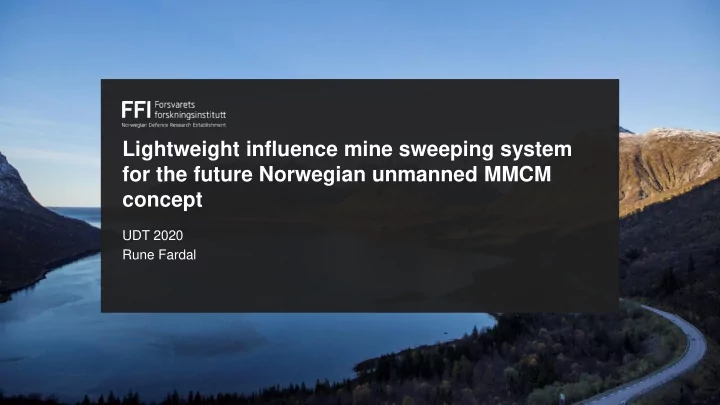

Lightweight influence mine sweeping system for the future Norwegian unmanned MMCM concept UDT 2020 Rune Fardal
Introduction
The Importance of Maritime MCM Open Sea Line of Communication (SLOC) and protection of harbors are essential for most civilian and military activities • Sea mines are definitive sea denial weapons • Suspicion of a mine threat will effectively stop all traffic • Naval operations will stop until area is cleared • Sea mines are efficient – Cheap, effective and hard to counter Norway has a long coastline (approx. 1650 miles) and must: • secure SLOC • protect naval assets from mine threat • prepare for allied support • Rough bathymetry, high clutter density, deep and shallow water calls for mine sweeping capability
Current Norwegian MCM Capability • Norwegian Navy MCM capability: – Mine diver command – 2 Oksøy-class mine hunting vessels – 2 Alta-class mine sweeping vessels • Building period 1990-1995 – Originally 4 hunt and 5 sweep • Expected life time – 25 years – MoD has started the procurement programme P6359 «Future maritime mine countermeasures capability»
Norwegian Need for Mine Sweeping Capability • In Norwegian waters relevant for mine clearance operations more Seafloor with rough bathymetry (left) than 50% are unsuitable for mine and high clutter density (right). hunting – A robust mine sweeping capability is Each image is approximately needed 300m x 300m. • High speed operations may require mine sweeping • The influence sweeps are used in: – Mine Setting Mode (MSM) – Target Simulation Mode (TSM)
P6359 Future Norwegian MMCM capability • 2017 – 2019: Conceptual phase. • 2020 – 2021: Definition phase. • 2022 – 2028: Project phase. (IOC: 2026, FOC: 2028)
Manned vessel Transit Mine sweep Mine divers Mine hunt Disposal
R&D areas at FFI for future USV based mine sweeps • Ship signature studies and mine/ship interaction studies. – National requirements for sweep sources. • Investigate technological maturity of relevant mine sweeping systems • Develop and adapt technology for Norwegian needs. • P&E software for influence mine sweeping.
Collaborative development The Norwegian military AUV program, an example of a collaborative development RNoN / NDMA Requirements CONOPS HUGIN Commercial delivery CD&E Support KONGSBERG FFI Collaborative development
Single USV with Straight tail cable sweep • Mine Setting Mode (MSM)
2 USVs with Closed Loop Cable Sweep • Target Simulation Mode (TSM)
Relevant acoustic lightweight sources • Thales Australia – Cable Powered Advanced Acoustic Source (CP-AAG) • Patria Finland – AK-20 • FFI will get detailed measurements of the sources in EDA project MLM-2
Sweeping tests 2018 KNM Mjølner Fwd cross cable Aft cross cable Acoustic source 1 Buoyancy elements Acoustic source 2 KNM Sleipner
Sweeping tests 2019 • 2 USVs • Launched from land • Towed at 8 kts
Launch and recovery • The complete electromagnetic and acoustic sweep can be launched from land or ship. – “Clip-on” solution where the sweep is attached to the USV(s) and towed into the area of operation. • Similar procedures for LARS of straight tail and closed loop configuration – Closed loop is more complex making the launch and recovery phases more advanced and time consuming
Conclusions and summary
Recommend
More recommend